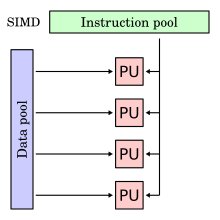Taksonomia Flynna
Taksonomia Flynna – klasyfikacja architektur komputerowych, zaproponowana w latach sześćdziesiątych XX wieku przez Michaela Flynna, opierająca się na liczbie przetwarzanych strumieni danych i strumieni rozkazów.
W taksonomii tej wyróżnia się cztery grupy:
- SISD (ang. single instruction, single data) – przetwarzany jest jeden strumień danych przez jeden wykonywany program - komputery skalarne (sekwencyjne).
- SIMD (ang. single instruction, multiple data) – przetwarzanych jest wiele strumieni danych przez jeden wykonywany program - tzw. komputery wektorowe.
- MISD (ang. multiple instruction, single data) – wiele równolegle wykonywanych programów przetwarza jednocześnie jeden wspólny strumień danych. W zasadzie jedynym zastosowaniem są systemy wykorzystujące redundancję (wielokrotne wykonywanie tych samych obliczeń) do minimalizacji błędów.
- MIMD (ang. multiple instruction, multiple data) – równolegle wykonywanych jest wiele programów, z których każdy przetwarza własne strumienie danych – przykładem mogą być komputery wieloprocesorowe, a także klastry i gridy.
Linki zewnętrzne
- Strona Michaela Flynna. arith.stanford.edu. [zarchiwizowane z tego adresu (2007-10-11)].
Media użyte na tej stronie
(c) I, Cburnett, CC-BY-SA-3.0
Flynn's Taxonomy of a MIMD design: multiple instruction, multiple data. Each "PU" (processing unit) does not necessarily correspond to a processor, just some functional unit that can perform processing. The PU's are indicated as such to show relationship between instructions, data, and the processing of the data.
(c) I, Cburnett, CC-BY-SA-3.0
Flynn's Taxonomy of a SISD design: single instruction, single data. Each "PU" (processing unit) does not necessarily correspond to a processor, just some functional unit that can perform processing. The PU's are indicated as such to show relationship between instructions, data, and the processing of the data.
(c) I, Cburnett, CC-BY-SA-3.0
Flynn's Taxonomy of a SImD design: single instruction, multiple data. Each "PU" (processing unit) does not necessarily correspond to a processor, just some functional unit that can perform processing. The PU's are indicated as such to show relationship between instructions, data, and the processing of the data.
(c) I, Cburnett, CC-BY-SA-3.0
Flynn's Taxonomy of a MISD design: multiple instruction, single data. Each "PU" (processing unit) does not necessarily correspond to a processor, just some functional unit that can perform processing. The PU's are indicated as such to show relationship between instructions, data, and the processing of the data.







